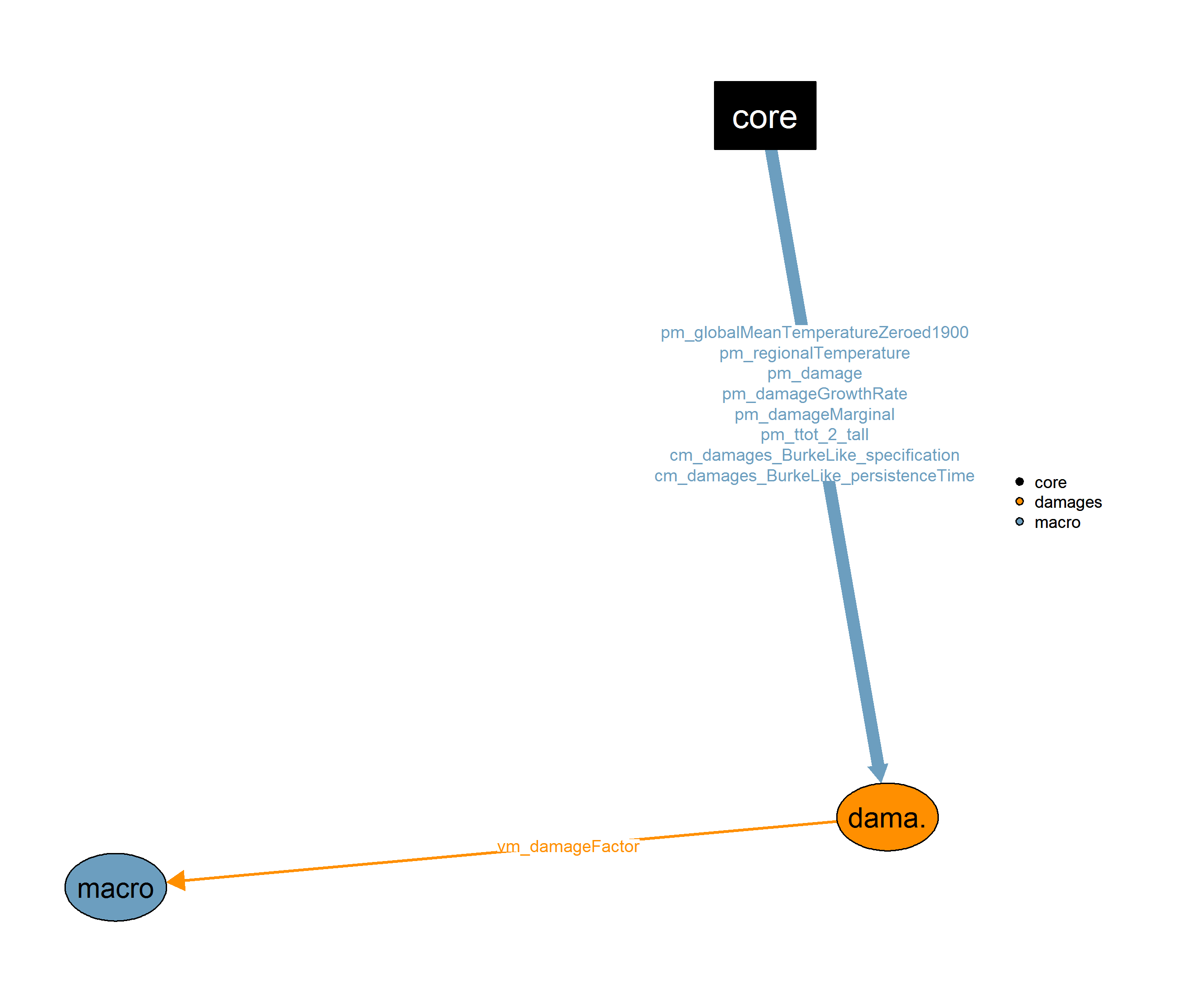Damages (50_damages)
Description
If turned on, the 50_damages module calculates damages between iterations based on global mean temperature paths from MAGICC. Different damage specifications are available, currently based on DICE and Burke, Hsiang, and Miguel (2015). Damages are internalized in the optimization in module 51_internalizeDamages. Without that, they enter the optimization as a fixed variable reducing output in the budget equation. The method and the advanced specification of the Burke damage function are described in Schultes et al. (2020).
Interfaces

Input
| Description | Unit | A | B | C | |
|---|---|---|---|---|---|
| cm_damages_BurkeLike_persistenceTime | persistence time in years for Burke-like damage functions | x | |||
| cm_damages_BurkeLike_specification | empirical specification for Burke-like damage functions | x | |||
| pm_damage (tall, all_regi) |
damage factor (reduces GDP) | x | x | ||
| pm_damageGrowthRate (tall, all_regi) |
damage function for growth rate of GDP | x | |||
| pm_damageMarginal (tall, all_regi) |
damage function derivative | x | x | ||
| pm_globalMeanTemperatureZeroed1900 (tall) |
global mean temperature anomaly, zeroed around 1900 | x | |||
| pm_regionalTemperature (tall, all_regi) |
regional temperature | x | |||
| pm_ttot_2_tall (ttot, tall) |
mapping from ttot to tall | x | x |
Output
| Description | Unit | |
|---|---|---|
| vm_damageFactor (ttot, all_regi) |
damage factor reducing GDP |
Realizations
(A) BurkeLike
Output damages are calculated based on the damage function from Burke, Hsiang, and Miguel (2015), extended by a finite persistence term. The details are described in Schultes et al. (2020). The persistence is a parameter to be specified in the config file (cm_damages_BurkeLike_persistenceTime). Two different damage realizations can be chosen via the switch cm_damages_BurkeLike_specification. “0” uses the short-run specification without lags, “1” the long-run specification. Damages are calculated on the regional level, the global temperature path from MAGICC is scaled to REMIND regions in module 16_downscaleTemperature, requiring the setting downscaleTemperature=CMIP5. (???): Currently only valid for RCP2.6, as for higher RCPs there is no limit for too extreme out-of-sample extrapoliations in terms of temperature (as it is done in Burke paper). Also the temperature downscaling requires a scaling parameter which is currently only included for RCP2.6 and RCP8.5 and for SSP2 population. Furthermore, unless the realization “BurkeLikeItr” is used for module 51_internalizeDamages, the damages are not actually part of the optimization, but just enter as a fixed variable reducing output, updated in between iterations.
Limitations There are no known limitations.
(B) DiceLike
Output damages are calculated based on the DICE-based damage function (see Nordhaus and Sztorc (2013)). Three different specifications can be chosen: DICE2013R, DICE2016 or Howard (Howard and Sterner (2017)) through the switch cm_damage_DiceLike_specification. They are based on the global mean temperature pathway from MAGICC. (???): Unless the realization “DiceLikeItr” is used for module 51_internalizeDamages, the damages are not actually part of the optimization, but just enter as a fixed variable updated in between iterations.
Limitations There are no known limitations.
(C) off
The off-realization of the damage module sets the damage factor on output to 1, meaning no damage.
Limitations There are no known limitations.
Definitions
Objects
| Description | Unit | A | B | C | |
|---|---|---|---|---|---|
| p50_damageFuncCoef1 | coef1 of damamge function | x | x | ||
| p50_damageFuncCoef2 | coef2 of damamge function | x | x |
Sets
| description | |
|---|---|
| all_regi | all regions |
| in(all_in) | All inputs and outputs of the CES function |
| modules | all the available modules |
| regi(all_regi) | all regions used in the solution process |
| tall | time index |
| ttot(tall) | time index with spin up |
Authors
Anselm Schultes
See Also
References
Burke, Marshall, Solomon Hsiang, and Edward Miguel. 2015. “Global Non-Linear Effect of Temperature on Economic Production.” Nature 527: 235–39. https://doi.org/doi:10.1038/nature15725.
Howard, Peter H., and Thomas Sterner. 2017. “Few and Not so Far Between: A Meta-Analysis of Climate Damage Estimates.” Environmental and Resource Economics 68: 197–225. https://doi.org/DOI 10.1007/s10640-017-0166-z.
Nordhaus, William, and Paul Sztorc. 2013. DICE2013R: Introduction and User’s Manual. http://www.econ.yale.edu/~nordhaus/homepage/homepage/documents/DICE_Manual_100413r1.pdf.
Schultes, Anselm, Gunnar Luderer, Franziska Piontek, Bjoern Soergel, Joeri Rogelj, Elmar Kriegler, and Ottmar Edenhofer. 2020. “Persistent Economic Damages Determine Social Costs of Carbon.”